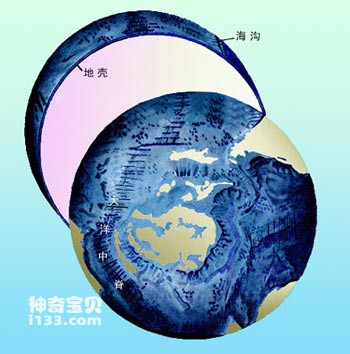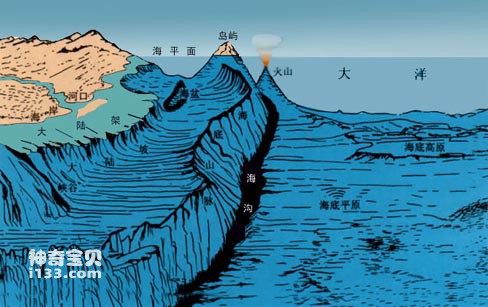The seafloor is part of the earth's surface. The seabed is not as flat as we imagine. If the sea really turns into a mulberry field, we will find that the appearance of the underwater world is very similar to the land we live on: majestic mountains, deep trenches and canyons, and vast plains . The seafloor of the world's oceans is like a large basin, with a shallow continental shelf on the edge and a deep-sea basin in the middle. There are mountains, deep valleys and abyssal plains on the ocean floor. The Mariana Trench in the Pacific Ocean is so unbelievably deep that if you put the world's highest peak into it, it wouldn't even come out of the water.

Undersea landforms on Earth
People understand the structure of the submarine crust through seismic waves and gravity measurements. The oceanic crust is mainly a basalt layer, about 5,000 meters thick, while the continental crust is mainly a granite layer, with an average thickness of 33 kilometers. The ocean floor is always renewing and growing, and the new ocean floor expands by about 6 centimeters every year. The mid-ocean ridge is the "backbone" that raises the ocean floor. The total length of the world's mid-ocean ridge is about 80,000 kilometers. It accounts for 1/3 of the bottom area of the moon, and seafloor spreading starts here.

3D schematic diagram of seabed landforms
Based on a large amount of bathymetry data, people have clearly understood that the basic outline of the seabed is as follows: the coastal land extends outward from the coast, which is a relatively flat seabed with a small slope. This area is called the "continental shelf"; Outward is a rather steep slope, which drops sharply to a depth of 3,000 meters. This slope is called the "continental slope"; from the continental slope down is the bottom of the vast ocean. Of the entire ocean area, the continental shelf and continental slope account for about 20%, and the ocean floor accounts for about 80%. If we draw the outline of the bottom of the ocean as a schematic cross-section, it looks a bit like a basin.
The seafloor topography of shallow continental shelf seas generally has little undulations, and is covered with a layer of sand and gravel of varying thicknesses, which are mainly transported from land by rivers. However, in some places, such as the Pacific coast of North and South America and the Mediterranean coast, the mountains are close to the seaside, and the seabed terrain is relatively rugged and steep; in some places, such as the coast of the Yellow Sea in my country and the estuaries and bays downstream of large rivers, the terrain is flat on the land and the seabed is flat. It is also a broad continental shelf with little undulations.
The bottom of the ocean is several kilometers deep. The ocean floor is mainly composed of deep-water basins, abyssal plains, large-scale submarine mountains and submarine plateaus; there are also some isolated ocean floor volcanoes, huge coral islands and reefs, etc. These landforms are different from landforms and are formed in the ocean. The bottom surface of the ocean is covered with a thin layer of seafloor sediment called deep-sea ooze.
Why does the seafloor have such an outline? Why are there such huge differences between the continental shelf, continental slope and ocean floor? This is due to the crustal structure of the seafloor.
In the entire underwater world, the ocean accounts for about 80% of the total area of the ocean. The majestic undersea mountains, vast undersea plains, and deep trenches are all covered with sediments of varying thicknesses, fiery red or black. The ocean is decorated with majestic Majestic and majestic.
animal tags:
We created this article in conjunction with AI technology, then made sure it was fact-checked and edited by a Animals Top editor.